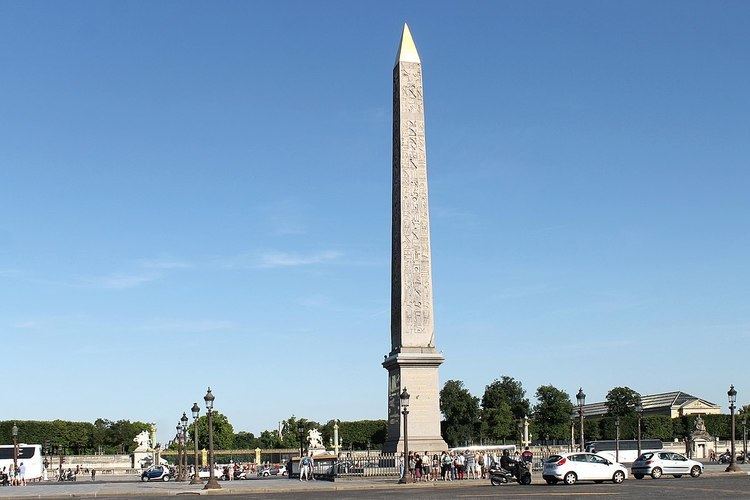 | ||
Address Place de la Concorde, 75008 Paris, France Hours Open today · Open 24 hoursWednesdayOpen 24 hoursThursdayOpen 24 hoursFridayOpen 24 hoursSaturdayOpen 24 hoursSundayOpen 24 hoursMondayOpen 24 hoursTuesdayOpen 24 hours Similar Place de la Concorde, Arc de Triomphe, Tuileries Garden, La Madeleine - Paris, Arc de Triomphe du Carro | ||
The Luxor Obelisk (French: Obélisque de Louxor) is a 23 metres (75 ft) high Egyptian obelisk standing at the center of the Place de la Concorde in Paris, France. It was originally located at the entrance to Luxor Temple, in Egypt. The Luxor Obelisk was classified as a historical monument in 1936.
Contents
This site was the location of the metro station, Concorde.
Drone view of the luxor obelisk paris france
History
The Luxor Obelisk is over 3,000 years old and was originally situated outside of Luxor Temple, where its twin remains to this day. It first arrived in Paris on December 21, 1833, having been shipped from Luxor via Alexandria and Cherbourg, and three years later, on October 25, 1836, was moved to the center of Place de la Concorde by King Louis-Phillipe. It was gifted to France by Muhammad Ali, Ruler of Egypt.
In August 1832, the French paddle ship Sphinx sailed to Alexandria to rendezvous there with the barge Louqsor, which was to load the Luxor Obelisk and bring it to Paris. Sphinx then towed Louqsor back to France. The ships departed on 1 April 1833 and reached Toulon on 10 May. The ships arrived at Cherbourg on 12 August 1833.
Features
The obelisk, a yellow granite column, rises 23 metres (75 ft) high, including the base, and weighs over 250 metric tons (280 short tons). It is decorated with hieroglyphs exalting the reign of the king Ramses II.
Given the technical limitations of the day, transporting it was no easy feat: The French government ordered a purpose built seagoing lighter built by the Toulon naval yard; this 49 metres long, flat bottomed, three masted ship named the Louqsor was sailed up the Nile to Luxor where 300 workmen dug a canal to allow the ship to come close to the obelisk. The team of French seamen carefully lowered the obelisk with a complicated array of blocks and tackles, yardarms and capstans. The re-erection of the obelisk on the Place de la Concorde during a ceremony carefully planned by king Louis Philippe was no mean engineering feat either. It is to be noted that in a time of rapidly evolving engineering techniques the successful French transport operation predates the eventful transport of the British "cleopatra needle" by more than thirty years. The present day pedestal was originally intended for an equestrian statue of king Louis XVI by Cortot, destroyed during the Revolution of 1830. On the pedestal are drawn diagrams explaining the complex machinery that was used for the transportation. The obelisk is flanked on both sides by fountains constructed at the time of its erection on the Place.The original Egyptian pedestal included the statues of sixteen fully sexed baboons and was deemed too obscene for public exhibition, it is displayed in the Egyptian section of the Musée du Louvre.
Missing its original pyramidion (believed stolen in the 6th century BC), the government of France added a gold-leafed pyramid cap to the top of the obelisk in 1998.
